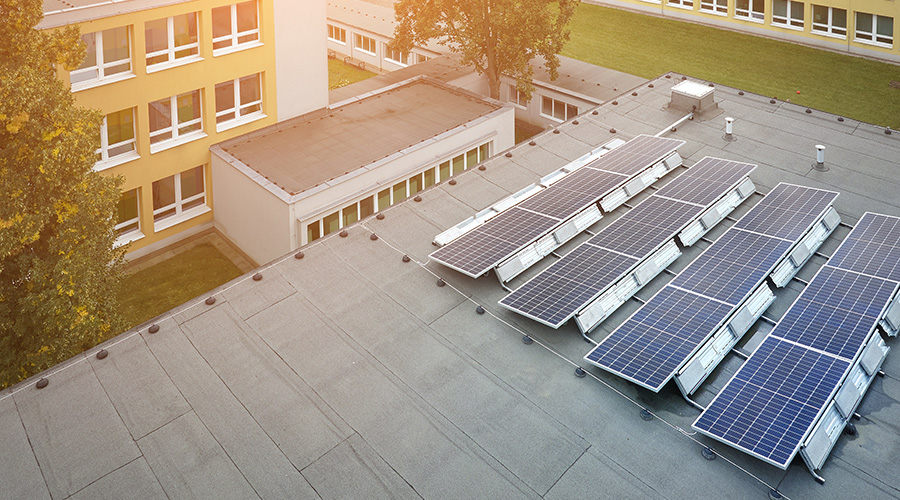When Enrollment Soars
Rapidly expanding districts grapple with mounting pressure to provide efficient and equal facilities
A rising student population can create major challenges for schools. The challenges are both quantitative and qualitative — making sure education facilities have enough physical space while ensuring that facilities also meet the varying educational needs of all students, faculty and staff. Consider the case of one Texas school district.
“We’ll be opening five schools per year as far as we can see,” says Blake Vaughn, the director of maintenance at Frisco (Texas) Independent School District. “Right now, we have 33 schools, and we project to have 54-55 schools within the next 10 years.”
In the last nine years, the district’s enrollment has grown about 20 percent a year. To meet the needs of this burgeoning population, the district opened two new high schools and three elementary schools this year.
One result of this growth is a substantial increase in the maintenance workload.
“In the past, we’ve been able to get a two-day turnaround on all work orders,” Vaughn says. “Now, we’re beginning to use a priority line item on our work order form — high, medium and low — to determine which ones we should complete first.”
More work for maintenance and engineering departments is not the only impact of soaring K-12 enrollments nationwide. To successfully meet the challenge, managers will need to reconsider how their facilities use space, compare the performance and amenities of new and existing facilities, and work closely with other departments, including construction and administration.
Space Assessment
As schools reach their maximum occupant-capacity levels, managers in districts nationwide are looking high and low for opportunities to maximize the space they have.
“Some of our elementary schools now have more than 1,000 students” and should be divided into two schools, says Rudy Flores, executive director for engineering facilities and planning at Tucson (Ariz.) Unified School District. While many of the schools on the east side of Flores’ district are not overcrowded, nearly every school in the district’s southeast is well above ideal student-capacity levels.
Flores’ space challenges were compounded this year when the district’s board voted to reduce class sizes in its schools.
“When you do that, you need more classrooms, even though you have the same population,” Flores says.
Stephen Snarr, director of facilities management services at Prince William County (Va.) Schools, faces a similar dilemma due to a soaring enrollment of students whose primary language is not English. To meet the educational needs of these students, the buildings need additional areas that can accommodate smaller groups, Snarr says. He estimates that the total enrollment in his district has grown 2,500-3,000 students a year for the last eight years.
Many districts create more space for students by turning non-educational areas, such as storerooms, into classrooms. The tactic can create other challenges, however.
“Taking a storeroom and changing the lighting, installing the ceiling and flooring, and sticking an 8-foot chalkboard on the wall is not very hard,” he says. But the conversion takes time, particularly when it comes to meeting HVAC requirements for such an area.
“A lot of times, we’ll heat those areas with electric strip heat, and the air conditioning and ventilation we provide through a small split system that we put on the roof,” he says.
To avoid future issues in such areas, managers can work with their district’s construction department to discuss problem areas in existing facilities.
“In some of the earlier designs on our elementary schools, we had a large common area that had some dead space,” Vaughn says. With the construction of each new school, the district tweaks the building design to maximize the use of square footage and eliminate dead space.
Talking Points
Communication is critical for resolving problems related to growing enrollment. Regular conversations with district officials who make enrollment projections should be a particular objective for all maintenance and engineering managers. Doing so can help managers project department workloads.
“We’re doing a better job at making projections,” Snarr says, adding that preparations for higher student enrollment have become an annual process at his district.
Enrollment projections are based on such data as the construction of new subdivisions. In early spring, Snarr and other individuals, such as principals and those in charge of analyzing population-related data, review population and enrollment projections for their district and make decisions, such as where Snarr’s department should move portable classrooms to accommodate overcrowded schools.
The process also gives Snarr enough lead time to take any steps necessary to accommodate students for the upcoming school year, such as acquiring permits from the county for installing trailers.
In making accommodations to handle shifting enrollments, managers must be aware of community concerns regarding their decisions, such as the placement of portable classrooms.
“How many trailers will a site accommodate until the community gets in an uproar?” Snarr asks. Managers and other district officials need to take such concerns into account during the planning process.
For more information on portable classrooms by school districts, see the accompanying article on page 8.
Because a growing number of school districts are undertaking major expansion and renovation projects to accommodate more students, it is also essential that managers work closely with their districts’ construction department and contractors.
“One of the challenges we have is making sure that the contractors don’t interfere with the education process,” Snarr says. As an example, he cites indoor air quality issues that can arise when contractors work in occupied buildings.
“If they are causing dust, we’ll make sure the students’ area is segregated from the construction area,” he says. To solve the problem, “we bought a number of negative air machines that asbestos contractors use. We hook them up in the classrooms that are being renovated just to remove the dust.”
School expansion projects also can create a host of maintenance and engineering issues that mangers must address. These include everything from ensuring that building HVAC systems in the addition are compatible with systems in the existing facility to increasing the amount of parking, Flores says.
Ensuring Equality
As districts add schools, managers should be on the lookout for disparities between the new and existing schools, which can create issues of educational equality. Most often, new schools feature higher-efficiency building systems, such as touchless plumbing fixtures, and more technology amenities, such as wireless internet access.
“As you start to see the new buildings come up, you hear the word equality a lot,” Vaughn says. To ensure a quality education for all students, managers might need to upgrade aging facilities.
Bill Kolster, director of facility services for Loudoun County (Va.) Public Schools, says his district has undertaken an aggressive renovation program over the past five years to make its older schools as close to equal as possible with its new schools. Growing at an average rate of eight to nine percent a year, his district has faced its share of equality discussions as it increased from 35 schools to 68 schools since 1997.
The renovations included a variety of projects, from system upgrades to major expansions.
“When we started creating computer labs, we had to modify classrooms in the existing schools to serve as the labs,” Kolster says. Because of the classrooms’ configuration, it was difficult to modify them to accommodate 28 students and still provide an efficient learning environment.
“The new schools had purpose-built computer labs that were much more efficient for teaching,” he says,. In these classrooms, children sit around the perimeter while the teacher uses the center of the room for demonstrations.
“As we renovate, we are making sure all of the schools have a dedicated computer lab built to the current configuration,” he says. The district is also renovating its middle schools’ art rooms to provide more natural light.
“In our renovations, we’re putting our art rooms, which were in the center of the building, on the exterior walls so they can have outside views and the kind of environment that artists thrive in,” he says.
Maintenance and engineering managers who focus solely on the construction of new schools to keep up with soaring enrollments run the risk of overlooking educational equality issues. So in carefully assessing their district’s facilities, they can help ensure that all students have the opportunity to attend a school that provides a healthy indoor environment that paves the way for proper learning.
Portable Classrooms: The Inside Story
To help alleviate space challenges created by growing K-12 enrollments nationwide, many school districts have turned to portable classrooms.
"We have one elementary school right now that has 13 classroom trailers," says Stephen Snarr, director of facilities management services at Prince William County (Va.) Schools. "Next spring, we are opening an elementary school that is going to take about half of those students out of that building, and we will be able to remove those trailers."
Snarr's district uses 241 classroom trailers, of which about 200 are 14- by-56-foot units that can move between sites. The remaining trailers are larger, modular units that require construction and have as many as 10 classrooms. Having the flexibility to move the smaller trailers has been critical for the district, which moved 50 of them last summer to overcrowded schools.
"We might have a school site with eight trailers," he says. "Then, we’ll build a new school, and we’ll go down to four trailers at that site. Then a year or two later, we’ll be back up to eight or nine trailers at that site."
Before placing trailers, managers must first consider issues such as local building codes. Under Virginia code, the trailers can't be closer than 35 feet to the main building, Snarr says.
"We get them as close to the building as we can, usually the academic part of the building, someplace that is easy access to and from the building, someplace that has bathroom inside the building readily available,” he says. To keep the school site aesthetically appealing, Snarr puts them behind the building when possible.
Snarr's department tries to make the trailers as secure as the building classrooms. Setting them up includes laying foundations; connecting power, two-way intercoms, fire alarms and computer lines; installing HVAC systems; mounting steps and ramps; and putting canopies over the main doors and skirting around them.
IAQ Issues
A growing concern regarding portable classrooms is indoor air quality (IAQ). In recent years, several organizations, including the U.S. Environmental Protection Agency (EPA) and the American Society of Heating Refrigerating and Air-Conditioning Engineers (ASHRAE), have taken a closer look at this issue.
In November 2004, the California EPA Air Resources Board (ARB) released results from a study focusing on the environmental health conditions in portable classrooms. Researchers analyzed the IAQ in portable classrooms and compared that data to air samples they took from traditional classrooms. The study identified environmental problems, such as inadequate ventilation and poor thermal comfort, in several portable classrooms in California.
"Many of the problems they found in portable classrooms can be mitigated through maintenance practices," says Gennet Paauwe, spokesperson for ARB. Managers can avoid many IAQ problems by specifying units constructed of materials that emit low levels of volatile organic compounds (VOCs) and cleaning the interior with low-VOC products, she says.
Managers also might consider specifying low-noise HVAC systems for portable classrooms.
"Often, teachers in portable classrooms turn off the ventilation system because they find they have to yell over the din of the system to talk to their students," Paauwe says. Shutting off the system, however, reduces airflow and allows indoor pollutants to accumulate.
To view the full report, visit www.arb.ca.gov/research/indoor/pcs/pcs-fr/pcs-fr.htm
For more information on IAQ and portable classrooms, visit EPA's IAQ Design Tools for Schools web site, www.epa.gov/iaq/schooldesign/portables.html
— Renee L. Shroades
|
Related Topics:











